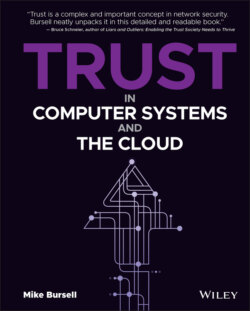Читать книгу Trust in Computer Systems and the Cloud - Mike Bursell - Страница 32
Trust, But Verify
ОглавлениеWithout wanting to focus too much on mistrust, we should not, however, assume good intent when interacting with other humans. Humans do not always do what they say they will do, as we all well know from personal experience. In other words, they are not always trustworthy, which means our trust relationships to them will not always yield positive outcomes. Not only that, but even if we take our broader view of trust relationships, where we say that the action need not be positive as long as it is what we expect, we can also note that humans are not always consistent, so we should not always expect our assurances to be met in that case, either.
There is a well-known Russian proverb popularised in English by President Ronald Reagan in the 1980s as “trust, but verify”. He was using it in the context of nuclear disarmament talks with the Soviet Union, but it has been widely adopted by the IT security community. The idea is that while trust is useful—and important—verification is equally so. Of course, one can only verify the actions—or, equally, inactions—associated with a trust relationship over time: it makes no sense to talk about verifying something that has not happened. We will consider in later chapters how this aspect of time is relevant to our discussions of trust; but Nan Russell, writing for Psychology Today about trust for those in positions of leadership within organisations,44 suggests that “trust, but verify” is only the best strategy when the outcome—in our definition, the actions about which the trustor has assurances of being performed by the trustee—is more important than the relationship itself. Russell's view is that continuous verification is likely to signal to the trustee that the trustor distrusts them, leading to a negative feedback loop where the trustee fails to perform as expected, confirming the distrust by the trustor. What this exposes is the fact that the trust relationship (from the leader to the person being verified) to which Russell is referring actually exists alongside another relationship (from the person being verified to the leader) and that actions related to one may impact on the other. This is another example of how important it is to define trust relationships carefully, particularly in situations between humans.
